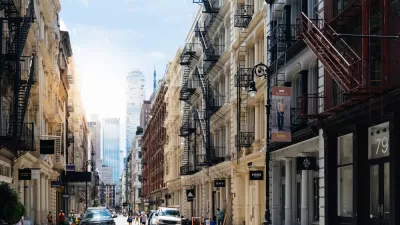A study recently published in the Journal of the American Planning Association finds that the APA's definition of "great neighborhoods" might be leaving low-income and minority populations behind.

Adapted from: Talen, Emily, Sunny Menozzi, and Chloe Schaefer. "What Is a 'Great Neighborhood'? An Analysis of APA's Top-Rated Places." Journal of the American Planning Association 81, no. 2 (April 3, 2015): 121–41. doi:10.1080/01944363.2015.1067573.
The American Planning Association's (APA) annual "Great Neighborhoods" program was established to define the "gold standard" of neighborhoods in America. The profession and the public perceive the designation as an authoritative and normative judgment about what a Great Neighborhood in America is supposed to be.
We wanted to know whether qualitatively better places are likely to lack affordability, and therefore diversity, is evident in the APA's Great Neighborhoods competition. Using Census and other data covering the 80 APA-designated Great Neighborhoods to date (2007–2014), we found that, unfortunately, yes—APA's Great Neighborhoods represent a somewhat classic conception of the historic, gentrifying urban neighborhood: walkable, gridded, and losing social diversity.
One finding was that there is a huge disparity in median housing price—a $108k difference—between "Great Neighborhoods" and the tracts that immediately surround them. We also looked at trends over time. In 1970, APA's Great Neighborhoods had a lower percentage of white residents and a higher percentage of black residents compared to other cities. But this racial profile reversed by 2010, when APA Great Neighborhoods had a higher percentage of white residents and lower percentages of black and Hispanic residents when compared with cities as a whole.
According to our analysis of the data, APA Great Neighborhoods have not bucked the trend that desirable physical qualities lead correspondingly to lack of affordability and social diversity.
What should APA do about that?
Historic, walkable neighborhoods in America are a treasure. But there is a downside: they are also often losing their diversity and affordability, often in places (centrally located, near transit) where diversity and affordability are most needed.
Of course, not all historic, walkable neighborhoods lack diversity—many neighborhoods do "have it all." Our point is that these are the neighborhoods that need to be recognized more fully and supported as the true "gold standard" of a Great Neighborhood in America.
Unfortunately, the APA seems to be agnostic on the issue of increasing income segregation. The maintenance of affordability and social diversity is not even an explicit criterion of what a "Great Neighborhood" is supposed to be. This defies a long-standing ethical principle in American city planning: that neighborhoods should be both well-designed and socially inclusive.
We wonder why APA isn't more concerned about the perception of insensitivity with respect to America's income and racial inequality drama—with its fundamental linkage to housing—now playing out across the land.
We wonder why APA is not more sensitive to the connection between a strong sense of neighborhood identity and the potential for social exclusion in their Great Neighborhoods designation. The APA should limit their gold standard to neighborhoods that score well on the APA's criteria but that also manage to retain affordability and social diversity.
Specifically, might APA consider adding the following as a criterion of a "Great Neighborhood":
- Where gentrification pressure is evident or likely, a "Great Neighborhood" shows a demonstrated commitment to the maintenance of affordability and social diversity.
We need APA to take a principled stand instead of further debating the merits of this issue. Why not specifically include affordability and the maintenance of social, racial, or ethnic diversity as a necessary criterion of a "Great Neighborhood"?
Emily Talen ([email protected]) is professor at the School of Geographical Sciences and Urban Planning at Arizona State University. Sunny Menozzi ([email protected]) and Chloe Schaefer ([email protected]) are recent graduates of the Department of Urban Studies and Planning at the Massachusetts Institute of Technology.

Planetizen Federal Action Tracker
A weekly monitor of how Trump’s orders and actions are impacting planners and planning in America.

San Francisco's School District Spent $105M To Build Affordable Housing for Teachers — And That's Just the Beginning
SFUSD joins a growing list of school districts using their land holdings to address housing affordability challenges faced by their own employees.

The Tiny, Adorable $7,000 Car Turning Japan Onto EVs
The single seat Mibot charges from a regular plug as quickly as an iPad, and is about half the price of an average EV.

With Protected Lanes, 460% More People Commute by Bike
For those needing more ammo, more data proving what we already knew is here.

In More Metros Than You’d Think, Suburbs are Now More Expensive Than the City
If you're moving to the burbs to save on square footage, data shows you should think again.

The States Losing Rural Delivery Rooms at an Alarming Pace
In some states, as few as 9% of rural hospitals still deliver babies. As a result, rising pre-term births, no adequate pre-term care and "harrowing" close calls are a growing reality.
Urban Design for Planners 1: Software Tools
This six-course series explores essential urban design concepts using open source software and equips planners with the tools they need to participate fully in the urban design process.
Planning for Universal Design
Learn the tools for implementing Universal Design in planning regulations.
Smith Gee Studio
City of Charlotte
City of Camden Redevelopment Agency
City of Astoria
Transportation Research & Education Center (TREC) at Portland State University
US High Speed Rail Association
City of Camden Redevelopment Agency
Municipality of Princeton (NJ)





























